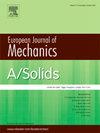Hexagonal element-based topology optimization of dual-axial compliant mechanisms with decoupled kinematics
IF 4.4
2区 工程技术
Q1 MECHANICS
引用次数: 0
Abstract
Compliant mechanisms are widely applied in fast-tool-servo machining and micro/nano-positioning devices. However, for multi-degree-of-freedom mechanisms, designing them is a multi-objective, multi-constraint problem where multiple factors need to be considered, such as large stroke, nanometer-level positioning accuracy, and static failure. Currently, traditional design methods may not be able to comprehensively address these factors. To solve these problems, this study proposes a topology optimization-based design method to develop a compliant mechanism with fully decoupled kinematics and two degrees of freedom, where a hexagonal element mesh with Wachspress shape functions is utilized. Besides, a coupling constraint formulation is designed to avoid the motion coupling in the input end and output end of the compliant mechanism and enhance positioning accuracy. Furthermore, a normalized p-norm stress method is used to restrict the compliant mechanism's maximum stress, which aims to prevent static failure and enhance its reliability. Finally, a dual-axial compliant mechanism with decoupled kinematics, as the numerical example, is designed by the proposed topology optimization method, and its performance specifications are verified by the finite element simulation, which demonstrates the effectiveness and superiority of the proposed topology optimization method on the design of the compliant mechanism.
解耦双轴柔性机构的六方元拓扑优化
柔性机构在快速刀具伺服加工和微纳定位装置中有着广泛的应用。然而,对于多自由度机构,其设计是一个多目标、多约束的问题,需要考虑大行程、纳米级定位精度、静态失效等多种因素。目前,传统的设计方法可能无法全面解决这些因素。为了解决这些问题,本研究提出了一种基于拓扑优化的设计方法来开发一种完全解耦的二自由度柔性机构,该机构采用具有wachpress形状函数的六边形单元网格。设计了耦合约束公式,避免了柔性机构输入端和输出端的运动耦合,提高了定位精度。采用归一化p范数应力法对柔性机构的最大应力进行了约束,防止了机构的静破坏,提高了机构的可靠性。最后,以解耦双轴柔顺机构为例,采用所提出的拓扑优化方法进行了设计,并通过有限元仿真验证了其性能指标,验证了所提出的拓扑优化方法在柔顺机构设计中的有效性和优越性。
本文章由计算机程序翻译,如有差异,请以英文原文为准。
求助全文
约1分钟内获得全文
求助全文
来源期刊
CiteScore
7.00
自引率
7.30%
发文量
275
审稿时长
48 days
期刊介绍:
The European Journal of Mechanics endash; A/Solids continues to publish articles in English in all areas of Solid Mechanics from the physical and mathematical basis to materials engineering, technological applications and methods of modern computational mechanics, both pure and applied research.

 求助内容:
求助内容: 应助结果提醒方式:
应助结果提醒方式:


